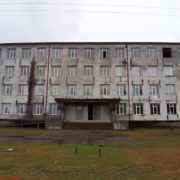
Rebuilding Education in Georgia: the Infrastructure Challenge in Georgia’s School System
Policy Paper
Key Findings
The physical condition of Georgian school buildings has long been a source of national concern. The vast majority of the country’s schools were built during the Soviet Union and, during the chaos and poverty that beset the country following independence, almost no maintenance and repair took place for fifteen years. Many people associate the schools of today with the 1990s, when children even in elite Tbilisi schools wore their winter coats and sat in classrooms with broken windows and kerosene stoves.
Thankfully, most Georgian children no longer have to endure such bleak conditions, but much remains to be done to bring the infrastructure of Georgian schools in line with international standards.
Beginning in 2006, Georgia started to invest major government spending on school infrastructure, and over the 15 years since, addressed the most egregious problems of schools. Yet, the situation remains dire and improvement is needed in most schools.
Based on the 2018-2019 public school infrastructure assessment database, which the report relies on heavily, just 51 schools, or 3% of all public schools in Georgia, are in good condition, and around half are in either poor condition, or need to be replaced entirely. Currently, over 33,000 children study in schools deemed as replacement, and a further 250,000—almost half of all public school students—study in buildings classified as “poor.” The condition of schools in rural areas is markedly worse.
Providing adequate heating and water to schools is inextricably mixed with general state of physical infrastructure in Georgian countryside: many places around the country still don’t have natural gas or running water access. However, immediately hooking up the schools in areas where there is natural gas or fixing the water systems to provide water to schools should be an absolute priority for any infrastructural development in rural areas. Similarly, internet connection in many places around rural Georgia is unstable, but educational infrastructural agencies should invest in strong wi-fi systems for schools for them to have better internet access, and update their old computers to use that internet connection.
Per the 2018-2019 assessment, the budget for the complete renovation of all existing schools is around GEL 1.6 billion. About a third of this sum, 551 million, is for urgent works. Overall, 64% of the total repairs budget would be for rural schools (which house just 30% of all students) and 36% for urban schools.
Since 2018, four different government agencies have spent a total of over GEL 350 million to address some of the infrastructural challenges of Georgian schools. However, it was not organized under a centralized plan or with the assistance of the assessment documents. Within that renovation, 77 new schools were built, but out of them, just 7 new schools were in cities, where demand is highest, and 70 were in villages around the country.
School infrastructure update is crucial, especially as high number of school buildings are in a dire state and close to 300 schools are in replacement condition. However, Georgian education policy should take a more holistic approach and look at long-term demographic, sociological data to measure long-term population trends and adjust building new schools and renovating the old/consolidating schools accordingly. Thus, any long-term projects on school infrastructure development should come in one package and be a part of regional (rural and urban) development, employment, municipal zoning, agriculture, and migration government policies.
Short term, in particular, the government of Georgia should find ways to build more schools in its urban areas, particularly to take pressure off overcrowded schools in Tbilisi, and to a lesser extent, Batumi. One policy could be to make it a legal requirement for developers to build schools if a development complex is over a certain number of units, or tax incentives for new developers to compel them to build schools in new development areas, or finding land for new schools and building them with state resources, in areas already built up, but with large student overcrowding.
Government of Georgia should make a concerted effort to organize and prioritize refurbishment of schools and building new ones based on data. The current situation where 4 organizations independently work on renovations is not ideal. Such organization could be done on the basis of the systematized infrastructure assessments or other type of information available to Ministry of Education and municipalities.
The organizations providing renovations should coordinate, either under a cross-cutting agency that would decide what to refurbish and rebuild first, or through municipalities, which would control schools in them and their refurbishment strategy. It is logical that the former is the short-term, and the latter a long-term optimal strategy.
Within that effort to organize, the government should be more responsive to address look at particular cases of issues with schools with outstanding, immediate problems (heating, water, toilets, internal infrastructure, or other issues) and address them without delay. It can read various reports on schools in extremely dire conditions in media or continue assessing all public schools in areas of concern internally.
Related Articles:
openDemocracy article on school infrastructure and other issues
The crisis of school canteens in Georgia
The Digital Divide – How the Pandemic Has Exposed Inequalities in the Georgian Education System
Related Blog Posts:
Issues with school renovations
Georgia’s public school infrastructure – How inclusive?
Georgia’s education policy and its demographic challenge
Lack of organized School Renovations after 2018
School overpopulation in Tbilisi
The idea of school districting
Illustration: School in Poti (Abkhazian School #21, IDP School)
Source: 2018-2019 public school infrastructure database compiled by GeoWel based on the data provided by ESIDA